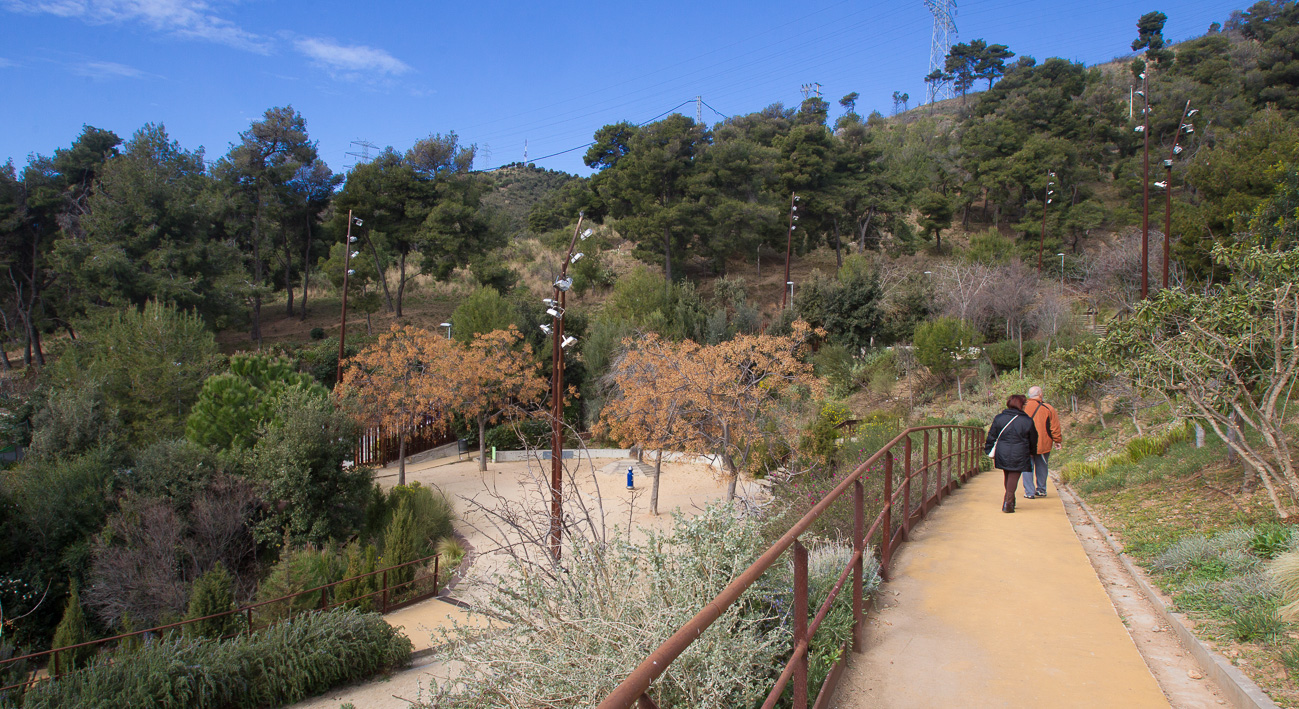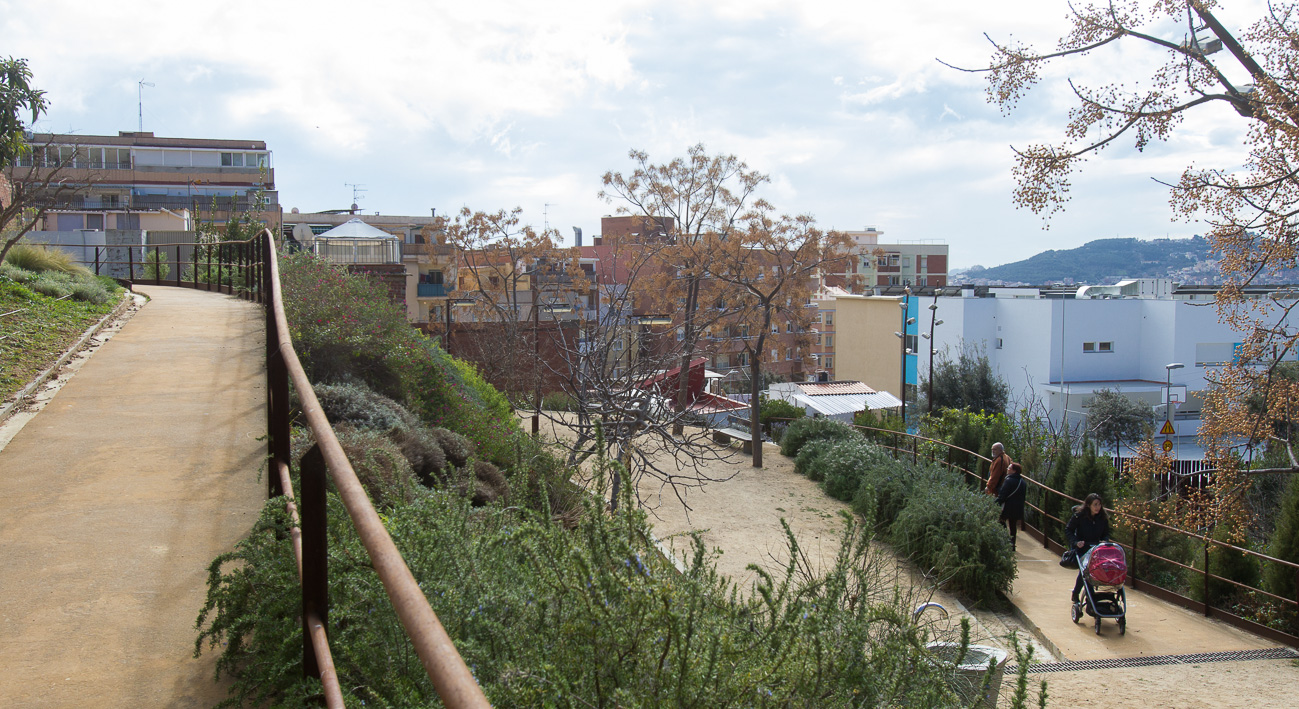These gardens have as many as 80 different aromatic, perennial grass species and nineteen tree species.

History
Rodrigo Caro’s landscaped slopes have helped to redevelop land which used to have a natural spring, in the heart of a rural area next to the Collserola mountain range and often visited by the residents of the Les Roquetes neighbourhood. In fact, it was thanks to the insistence of the local residents that this space was reclaimed.
The gardens have become a curious addition of the exotic, given the origin of their plants, which come from Chile, South Africa and Australia. There are geraniums growing there, next to plants from the region of Perth (Australia), planted by locals from the adjacent houses. They are flowers planted in domestic flowerpots, hung on the gabion walls that separate the gardens from the courtyards of the nearby houses. These flowerpots, now integrated into the gardens, epitomise the entire neighbourhood’s spirit and community. A very active neighbourhood that made these gardens one of their objectives.

Biodiversity
If you enter the gardens from the lower part, you will come across several varieties of rosemary (Rosmarinus officinalis), known locally as ‘Cap de pera ‘, ‘Boule‘ and ‘Manacor‘).
These rosemaries grow next to several species of irises, such as Iris germanica, Iris lutescens, Iris pallidaand Dietes grandiflora, and grasses, such as Stipa tenuissima, with a thick mane of leaves.
Rodrigo Caro has as many as nineteen different species of trees. The first specimen we find is an oleaster tree (Eleagnus angustifolia). Close by we also find sage scrub (Salvia officinalis, microphylla and fruticosa) and several collections of cistus (albidus, salvifolius, pulvurentus, purpureus and skanbergii). Here and there you will come across broom scrubs (Genista linifolia, Genista florida and Genista valentina) and groups of santolina (Santolina chamaecyparissus), curry plant (Helichrysum italicum) and oregano (Origanum vulgare), as well as well-known and lesser-known varieties of thyme (Thymus vulgaris, Thymus ciliatus, Thymus mastichina) and the Mediterranean garland thorn (Paliurus spina-christi) too. There are also loquats (Eriobotrya japonica), double-flower pomegranates (Punica granatum), a quince tree (Cydonia oblonga) and fig trees (Ficus carica), beneath which you can find species of grass such as lisum, nassella, known as needle grass (Nassella tenuissima), esparto grass (Lygeum spartum) and a close relative of giant feather grass (Stipa gigantea) growing next to the strawberry tree (Arbutus unedum). All the trees surrounding Rodrigo Caro are holm oaks (Quercus ilex), which you can also find inside the gardens (Quercus ilex and Quercus suber), near the pine trees (Pinus pinea and Pinus halepensis), laurustinus, mastic trees (Pistacia lentiscus), terebinths or turpentine trees
(Pistacia terebinthus) and oleanders (Nerium oleander).
There are also sections of flowers that look very much like daisies, such as Erigeron karvinskianus, which is native to Mexico and Central America.
Rare plants here include a lilac-coloured Australian flower that gives off an intense scent… of garlic. This is Tulbaghia violacia, popularly known as society garlic or South African wild garlic, of which there are two varieties in the gardens. The species is so resistant to droughts and saline soils, like Mediterranean salt brush (Atriplex halimus), that it can grow on banks by the sea.
The gardens’ other notable resistant plants include a group of cistuses and phlomis, such as Jerusalem sage
(Phlomis fruticosa), Balearic Island sage
(Phlomis italica) and purple Jerusalem sage (Phlomis purpurea).
The upper part of the garden has carob trees (Ceratonia siliqua) and tamarisks (Tamarix gallica and pentandra) and, as for shrubs, junipers (Juniperus phoenica), heather (Erica multiflora), myrtle (Myrtus communis) and a new species of rosemary (Rosmarinus postratus) which has the peculiarity of growing on curly creeper scrub.
There are also olive trees (Olea europaea) at the top of the grounds plus false olive trees (Phillyrea angustifolia) and New Zealand flax trees (Phormium tenax) next to the fence and all along the route round.

Art and Architecture
We recommend you visit these gardens going up, from the bottom to the top, keeping to the route marked out by the ramps. So, as you make your way up, the banks remain at eye-level and in front.
But the gardens also have a route that starts from the top, going down to the bottom. This is a particularly good option for people with reduced mobility. There is a lift that takes visitors up to the top of the hill, sparing you the need to walk up the gardens from C/ Alcàntara to C/ Llobera. Before you go up, however, don’t forget to make the most of the panoramic view of Barcelona from the highest part of the Roquetes hill.

Landscaping and Design
What makes this a collection is that the seeds of some species are taken from the Rodrigo Caro Gardens to supply the Tres Pins Nursery.
Rodrigo Caro used to be a source for a resistant species of grass, the Zoysia tenuifolia, known as Korean velvet grass. It is found extensively and luxuriously in the gardens, under Judas trees (Cercis siliquastrum) and pagoda trees (Styphnolobium japonicum).
The gardens are a testing lab. Some species are adapting and others are not. Good examples can be found with the Australian red, velvety-leaved yellow kangaroo paw (Anizoganthus flavidus) or with the African rosemary and Cape snow bush (Eriocephalus africanus and Eriocephalus capensis), from South Africa. Barcelona has reintroduced this African plant, as the Eriocephalus had disappeared. Another plant that has been reintroduced into the gardens, having vanished from ornamental landscaping, is spurge olive (Cneorum tricoccum).
-
- Titularity
- Public center
- Address:
- C Artesania, 79*LB
- Districte:
- Nou Barris
- Neighborhood:
- les Roquetes
- City:
- Barcelona
Timetable
| Periode | Dies | Hores | |
|---|---|---|---|
| de l'1 de novembre al 31 de març |
Tots els dies | de 10:00 h a 19:00 h | |
| de l'1 d'abril al 31 d'octubre |
Tots els dies | de 10:00 h a 21:00 h |
aproximada, en funció de
l'horari solar (tanquen
quan es fa fosc, al capvespre)






